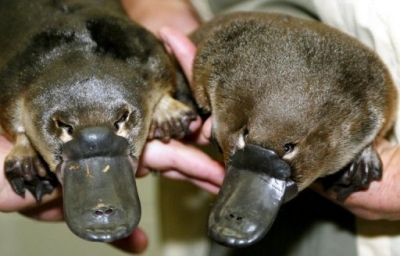
The platypus is one of the most unusual creatures in the animal kingdom. Platypuses (which is the correct plural form, not “platypi”) have a paddle-shaped tail like a beaver; a sleek, furry body like an otter; and a flat bill and webbed feet like a duck. In fact, the first time a platypus was brought from Australia to Britain, people couldn’t believe that it was a real animal.
A typical platypus is 15 inches (38 centimeters) from its head to the end of its rump. Its tail adds an additional 5 inches (13 cm) to the animal’s length. An individual weighs about 3 lbs. (1.4 kg), though platypuses that live in colder climates are bigger than those living in warmer areas, according to the Australian Platypus Conservatory.
Scientists have found fossils that suggest that ancient platypuses where twice as large as the modern variety, at 3.3 feet (1 meter) long.
Platypuses live in only one, small area of the world. These creatures make their homes in the freshwater areas that flow throughout the island of Tasmania and the eastern and southeastern coast of Australia. While they are in the water a lot, they will also waddle onto the riverbanks to dig burrows with their claws. These burrows are tunnels that have rooms or chambers. Platypuses also live under rock ledges, roots or debris.
Platypuses are carnivorous, which means they eat meat but not plants. They hunt for their food in the water where they live. As they swim, they try to detect food along the muddy bottom of the river, stream, pond or lake using their sensitive bills. When platypuses find something interesting, like shellfish, insects, larvae or worms, they scoop it up in their bills, store it in their cheek pouches and swim to the surface. Since they only have grinding plates and no teeth, platypuses use any gravel or dirt they scooped up while on the bottom of the waterbed to mash their food into digestible pieces.
Credit : Live Science
Picture Credit : Google




